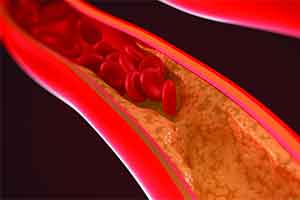Blood Vessel Calcification May Put Kidney Stone Formers at Increased Risk of Heart Disease
 Blood Vessel Calcification May Put Kidney Stone Formers at Increased Risk of Heart Disease
Blood Vessel Calcification May Put Kidney Stone Formers at Increased Risk of Heart DiseaseSuch build-up of calcium may also increase their risk of osteoporosis
Highlights
• People who develop recurrent kidney stones have more calcification in their arteries, which could explain their increased risk for heart disease.
• Kidney stone formers also have less dense bones, increasing their risk for osteoporosis.
Approximately 10% of men and 7% of women develop kidney stones.
Blood vessel calcification may put people who develop recurrent kidney stones at increased risk of heart disease, according to a study appearing in an upcoming issue of the Clinical Journal of the American Society of Nephrology (CJASN). The findings suggest that monitoring such calcification may help protect stone formers’ heart health.
About 10% of men and 7% of women develop kidney stones. Over the last decade, large epidemiological studies have shown that kidney stone formers have an increased likelihood of developing other conditions such as hypertension, chronic kidney disease and heart disease; however, the mechanisms involved are unknown.
Linda Shavit, MD (University College London Medical School, in the UK, and Shaare Zedek Medical Center, in Israel) and her colleagues wondered whether the heart problems experienced by kidney stone formers might be due to abnormal deposits of calcium in their blood vessels. Such vascular calcification is considered a strong risk factor for heart-related disease and death.
The researchers used computed tomography (CT) scans to evaluate the severity of abnormal calcium deposition in one of the largest blood vessels in human body, the abdominal aorta. Their study included 111 participants, of whom 57 were recurrent kidney stone formers and 54 were healthy controls.
The team found that people with kidney stones had more calcification in the abdominal aorta, which could explain their increased risk for heart disease. The investigators also found that stone formers had less dense bones compared with individuals who did not develop kidney stones. Previous studies have shown that vascular calcification often occurs alongside bone loss, suggesting a relationship between osteoporosis and atherosclerosis.
“Our findings raise several important questions that may be relevant to the care of patients with kidney stones,” said Dr. Shavit. “Existing CT can be a useful tool for assessment of aortic calcification and osteoporosis, along with kidney stone number and distribution. Moreover, preliminary experimental and clinical evidence suggests that therapeutic strategies aimed to treat osteoporosis may have a favorable effect on vascular calcification.” She noted that additional research is needed to confirm that heart disease can be reduced by measures aimed at identifying and reducing vascular calcification and osteoporosis in patients with kidney stones.
In an accompanying editorial, Eric Taylor, MD, MSc (Maine Medical Center and Brigham and Women’s Hospital) noted that the study raises a number of unanswered questions. “The nexus between calcium kidney stone formation, bone demineralization, and atherosclerosis should be an active area of investigation pursued by the clinical investigator and basic scientist alike,” he wrote. “Future studies will require careful assessment of calcium-phosphorus regulatory hormones and inhibitors of tissue calcification hypothesized to play important roles in the complex pathophysiology of all 3 disease states.”
Source Newsroom: American Society of Nephrology (ASN)
Citations
Clinical Journal of the American Society of Nephrology
“Vascular Calcification and Bone Mineral Density in Recurrent Kidney Stone Formers,” http://cjasn.asnjournals.org/


